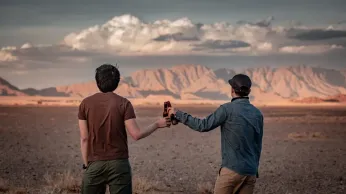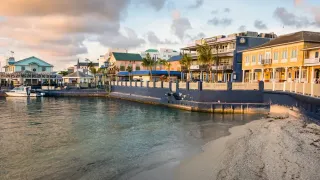
4 hours ago
Namibia Uncharted: A Quiet Oasis for Queer Travelers in Africa
READ TIME: 3 MIN.
Namibia is not the first name that comes to mind when considering LGBTQ+ travel in Africa. Unlike South Africa’s vibrant, visible queer culture or Mauritius’s recent legal strides, Namibia’s approach is quieter, subtler—yet increasingly meaningful for those who discover it. The country’s tourism sector, particularly its luxury lodges and safari operators, has long been accustomed to welcoming international guests with professionalism and respect, regardless of sexual orientation or gender identity . For queer travelers, this means the chance to experience one of Africa’s most visually stunning landscapes—from the towering dunes of Sossusvlei to the wildlife-rich Etosha National Park—without the scrutiny or discomfort that can accompany travel in less tolerant regions.
While public LGBTQ+ visibility remains low and same-sex relationships are not legally recognized, Namibia’s reputation for safety, political stability, and a growing, if still nascent, queer community makes it a compelling choice for travelers seeking both adventure and a respite from hypervisibility . The capital, Windhoek, is home to a small but active LGBTQ+ scene, with occasional social gatherings and a handful of queer-friendly venues. More importantly, the country’s sparse population and vast, open spaces offer a sense of privacy and freedom rare in more crowded destinations.
Namibia’s natural beauty is its calling card. The Namib Desert, one of the oldest and driest in the world, is a surreal expanse of rust-colored dunes and bleached salt pans. The Skeleton Coast, where the desert meets the Atlantic, is a place of shipwrecks, seal colonies, and haunting beauty. Inland, Etosha National Park teems with elephants, lions, and rhinos, while the Fish River Canyon offers some of the continent’s most dramatic hiking. For queer travelers, these landscapes are more than a backdrop—they are an invitation to introspection, connection, and a different kind of freedom.
Luxury lodges and safari camps, many of which are privately owned and internationally managed, are particularly attuned to the needs of diverse guests. Staff are trained to provide discreet, attentive service, and couples—regardless of gender—are treated with the same courtesy as any other guests . This professional hospitality, combined with Namibia’s low tourist density, means that queer travelers can enjoy intimate experiences—whether it’s a private sundowner on a dune, a gourmet dinner under the stars, or a guided walk through the desert—without fear of judgment.
Namibia’s LGBTQ+ community may not be large, but it is growing—and becoming more visible, especially among younger, urban Namibians. Windhoek hosts occasional queer events, from film screenings to informal meetups, often organized through social media or word of mouth. While there are no large-scale pride parades or overtly queer neighborhoods, the sense of solidarity and support is palpable among those who seek it.
Local LGBTQ+ activists and organizations, such as the Namibian Equal Rights Movement, continue to advocate for greater visibility and legal protections, though progress is slow and often met with resistance. For international visitors, this means that while Namibia may not offer the exuberant queer nightlife of Cape Town or the legal protections of Mauritius, it does provide a space where queer identities can exist quietly but authentically, supported by a network of allies within the tourism industry and beyond .
Namibia’s cultural tapestry is as diverse as its landscapes. The country is home to numerous ethnic groups, including the Himba, Herero, and Damara, each with their own traditions, languages, and ways of life. Queer travelers who take the time to engage with local communities—whether through guided cultural tours, craft markets, or community-run lodges—will find a warmth and curiosity that transcends the country’s conservative reputation.
In Swakopmund, a coastal town with a strong German colonial influence, the vibe is laid-back and artsy, with galleries, cafes, and a growing reputation for tolerance. In the north, the Caprivi Strip offers a taste of subtropical Africa, with river cruises, birdwatching, and encounters with local fishermen and farmers. Throughout the country, the emphasis on sustainable tourism and community involvement means that visitors can support local economies while experiencing authentic Namibian hospitality.
For queer travelers weary of the well-trodden paths to Africa’s more famous LGBTQ+ destinations, Namibia offers something different: a chance to explore one of the continent’s most breathtaking countries without the crowds, the performative allyship, or the pressure to conform. Its welcoming, professional tourism sector, combined with its natural wonders and emerging queer scene, makes it a destination where LGBTQ+ travelers can be themselves—quietly, confidently, and without compromise.
Namibia may not be on every queer travel list yet, but for those in the know, it’s a place where the desert’s silence speaks volumes, where the stars shine brighter, and where the promise of a truly inclusive African adventure is quietly becoming a reality .






